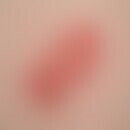Synonym(s)
HistoryThis section has been translated automatically.
DefinitionThis section has been translated automatically.
Rare, post-primary superficial paucibacillary inoculation tuberculosis due to exogenous reinfection or autologous superinfection after the tuberculous primary complex with partial immunity and normergic reaction of the organism. Infection occurs when handling material containing the pathogen.
Notice! Occupational disease of the skin (farmers, butchers, anatomists, pathologists).
You might also be interested in
EtiopathogenesisThis section has been translated automatically.
Typical post-primary re-infection of the skin with good immunity. Penetration of tubercle bacteria into the skin through small injuries. Frequently occurring in people who work in agriculture.
ManifestationThis section has been translated automatically.
Butcher's tubercle: mainly farmers, butchers, veterinarians. Mostly type bovinus; extremely chronic course.
Mild tuberculosis: Doctors, employees in pathological or anatomical institutes. Mostly type humanus, often acute course with tuberculous lymphangitis.
LocalizationThis section has been translated automatically.
ClinicThis section has been translated automatically.
Mostly blurred, round, oval or polycyclic, indolent or slightly touch-sensitive, brown-red, coarse, coarse, sloppy papules or plaques, occasionally papulopustules or erosions with crustal formations. Lesions are often surrounded by an inflammatory halo. The lesions show peripheral progression and central scarring. Secondary infections and regional lymph node swelling are common.
Note: Since mycobacteria cannot penetrate intact skin, the manifestations of infection are typically found at the site of injury.
HistologyThis section has been translated automatically.
DiagnosisThis section has been translated automatically.
Differential diagnosisThis section has been translated automatically.
Internal therapyThis section has been translated automatically.
Operative therapieThis section has been translated automatically.
Progression/forecastThis section has been translated automatically.
LiteratureThis section has been translated automatically.
- Barbagallo J et al (2002) Cutaneous tuberculosis: diagnosis and treatment. Am J Clin Dermatol 3: 319-328
- Chen Q et al (2019) Cutaneous tuberculosis: A great imitator. Clin Dermatol 37:192-199.
- Koch R (1890) Further news about a cure for tuberculosis. German med Wschr 16: 1029-1032
- Riehl G, Paltauf R (1886) Tuberculosis verrucosa cutis. Eline form of skin tuberculosis not yet described. Vjschr Derm Syph 13: 19-49
- Vora RV et al (2016) Tuberculosis verrucosa cutis with multifocal involvement. Indian Dermatol Online J 7:60-62.
Incoming links (16)
Blastomycosis, north american; Blastomycosis south american; Light tuberculosis; Nail, more painful; Porokeratosis mibelli; Riehl, gustav; Slaughterhouse tuberculosis; Slaughter tubercle; Swimming pool granuloma; Tuberculosis cutis luposa; ... Show allOutgoing links (10)
Blastomycosis; Bowen's disease; Bromoderm; Cutaneous tuberculosis (overview); Excision; Occupational skin disease according to BK 5101; Pyoderma vegetating; Squamous cell carcinoma of the skin; Tuberculosis cutis luposa; Verruca vulgaris;Disclaimer
Please ask your physician for a reliable diagnosis. This website is only meant as a reference.









